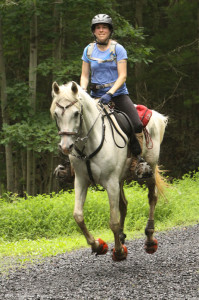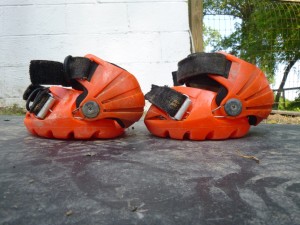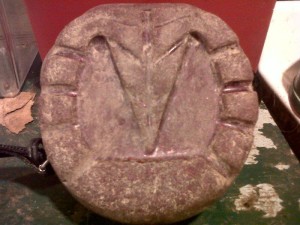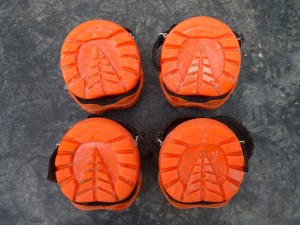Submitted by Jill Surkin, one of our beta testers for the new Viper™ model of boot being released.

photo by Becky Pearman
When I volunteered to give the Vipers a trial on the Old Dominion trails, I had NO IDEA they would get such a workout! “The Beast of the East,” the OD is known for its steep climbs and rocky terrain; this year, we added loads of mud into the mix! I was very impressed with the Viper’s performance on this difficult ride. I copied my ride report here in case you’re interested. I know it’s long — I think it’s a good story, though, with boot tidbits interspersed throughout. But if you just want to read my Viper summary, skip ahead to the last two paragraphs :)
OD Basecamp is in a valley at the bottom of a mountain. With torrential downpours on Thursday and steady rain all day Friday, it seemed like all the rain in the area was flowing straight into basecamp, which quickly turned into a sea of mud — over a foot deep in some places. The tractor was busy from Thursday straight through to Sunday, and some rigs needed up to 3 trucks to pull them out at the end. All of the horses were standing in mud all weekend, and some poor guys were in water up to their fetlocks! Everyone was worried about losing shoes due to hooves getting soft, and some people downgraded in distance as a precaution. And there was something metabolic going on, too! FIVE horses colicked on Friday, before even vetting in, and two of them had to be transported to a local clinic. There were theories flying around about something in the grass, or the sudden drop in air pressure due to the storms. A disappointing weekend for many people.
I had not even gotten a chance to try the Vipers on before we left, so I put them on Friday morning to go out for a little test ride. I did have to shorten the cables all around, and I had to shorten them A LOT on the back boots — the ends were sticking out when I was done. Next time I use them, I’ll put 00 cables on the back ones. However, even with the cables that short, I was still able to get the heel captivator down, something I couldn’t do with original Renegades unless I had the max cutback. So that was a nice bonus. We went out for about 5 miles and tested the boots at all 3 gaits, and they seemed fine — no twisting — but the rocky trails were much farther away, so I was still a bit worried how they would do during the ride. Nothing to do but go for it, though! I decided to carry two spare Renegades with me (one of each size) and put two more at the first hold just in case.
Shoes (pads recommended) or boots are required on all 4 feet at the OD, and they are diligent about verifying this. I vetted in barefoot on Friday afternoon, and several vets double checked to be sure I was booting. Nearly every horse at this ride had shoes, many with pads — all 20 of the 100 milers were shod, and only one other horse out of 57 in the 50 was booted.
Saturday morning, I got up at 5 AM to hold onto Sasha as the 100s left for their 5:15 start. Then it was time to have breakfast and get ready, as we started at 6:45. I feel like the Vipers go on much more easily than regular Renegades — I think maybe it’s the more streamlined sides of the captivators that allow them to rotate better? I have to have the captivators snugged up so close to the boot base that it’s always a struggle to get them down, but the Viper captivators went up and down much more easily. Anyway, I tacked up and started warming up. We got a few comments about our bright orange footwear, but after we had gone around basecamp once, they were completely covered in mud, so no more compliments after that :)
6:45 AM, off we go! I was most concerned about the section between the start and the first hold about 15 miles in, because Sasha starts very strong, and he would NOT be happy about stopping to mess around with boots. And the first section is very rocky, with a long climb and then a couple of miles along a ridge littered with boulders before heading back down to the hold. Lots of scrambling and places for boots to get wedged between rocks. Also, with all the rain, the places that weren’t rocky were very slick and muddy. So I leaned over constantly to do boot checks, but they stayed put.
In and out of the first hold with no problems. The second section is the hardest one, back up the mountain on an even steeper trail (1632 feet of elevation change over 2.2 miles, according to my GPS). The trail is very narrow, only room for one horse at a time, and very rocky. I rode up partway, then got off and started tailing. So I got to see the Vipers in action! They seemed to give very good grip, even over the big rocks. Once we got up the worst of it, I got back on. At the top of this hill, we traveled along another ridge, with rocks even worse than the previous one — big ones, little ones, scattered all over the trail. Many places where the horses have to scramble up piles of boulders. A horse lost his footing right under Sasha’s nose, and his whole hindquarters went off the side of the trail. He pulled himself back up and seemed ok, but it was scary to see!
A little farther along, we came to a pair of riders who were stopped on the trail. One girl’s horse had lost two shoes, and she only had one spare boot. By that time, I was pretty confident in the Vipers, so I said that I had a spare Renegade she could use. It fit perfectly, luckily, so I got back on and off we went.
At the second hold, the vet thought maybe Sasha was lame. So I pulled off the boots to check for pebbles, but they were clean inside. I put them back on and we trotted again for the head vet, and she said he looked fine. Whew! While Sasha was eating, the girl I had loaned the boot to came up to me to give it back, then said sadly that the farrier said her horse had worn down his hoof so much he couldn’t put a shoe on it. I said, “why are you giving me the boot back, then? Keep it and finish your ride!” (She found me after the finish to return the boot and said she would have been pulled without it. She was very impressed by how well it did.)
Sasha really struggled in the third section because he hadn’t been eating well, so we stayed an extra 20 minutes at the last hold. It put us way down in the standings, but I’m glad we stayed, because he finished the last 6 miles strongly, and we passed about 5 horses the last mile into the finish. We ended up 32nd out of 50, with a ride time of 8:55. This was probably the most difficult 50 I’ve ever done, due to the weather and trail conditions, so I’m super proud of our finish! There were quite a few lameness pulls, and only 12 horses out of 20 finished the 100.

All in all, I think the Vipers performed really well. They were even easier to put on than regular Renegades, they fit Sasha well with no twisting (even though he had some extra room on the sides due to that weird wide-heel issue), and he had no rubs at the end. The more aggressive tread gave him a lot of confidence over the rocks, much more than the shod horses, who were slipping all over the place. I’ve attached pictures of them showing the tread wear, as well as a picture from last year of a regular Renegade that started the ride brand new — when you compare them, the Vipers definitely have more tread left.
I got LOTS of comments and questions about them from vets, riders, and volunteers. Having the neon orange ones helped :) People were really impressed that I was doing this particular ride booted; honestly, considering how busy the farrier was all weekend, I think Sasha was the one with the advantage! One thing that kept coming up, over and over again, was people saying they got frustrated with boots and went back to shoeing. But the boots they were frustrated with were NOT Renegades :) I did lots of talking and explaining, and I think I got some people interested. I definitely get the impression, though, that people around here think that you can’t be competitive or do difficult rides in strap-on boots — but most of them either don’t know about, or have never tried Renegades. I honestly think they’re a superior product, and I’m thrilled that I can keep my horse barefoot and still compete on any terrain.
— Jill Surkin
A side-by-side comparison of Jill’s original Renegade® boots after the Old Dominion 50 in 2012, as compared to the Viper™ boots used this year. Both sets of boots were brand-new at ride start.
If you’re curious about the new Viper™, stayed tuned for upcoming news and more details, or call us at the factory and we’ll be happy to talk to you.


